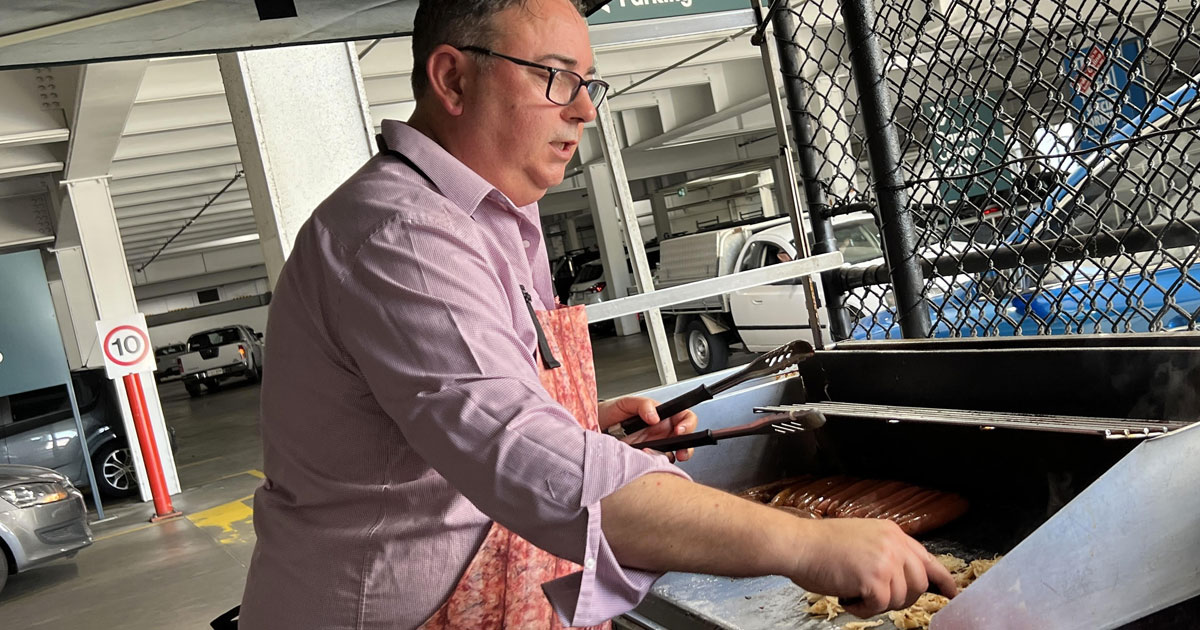The Australian sausage sizzle holds a special place in the heart of community fundraising efforts, serving as more than just a cheeky culinary tradition.
Last weekend, my venture behind the grill at Bunnings, aimed at supporting my daughter's journey to the national paddling championships, transformed from a simple act of service to a profound learning experience.
Without any prior experience and the pressure to succeed, I found myself in a situation mirroring the challenges faced by many small business owners: passionate about their craft yet needing to learn quickly as they navigate the complexities of running a business.
Setting Up And Finding A Pattern
The early moments of setting up the barbecue mirrored the critical initial stages of a business launch.
I was anxious to get going because I only had a vague idea of what to expect and whether or not I would be able to hold up my part of the sausage selling enterprise.
My father-in-law had prepared all the ingredients the night before, and my wife and daughters had the front-of-house system down pat (they'd done that before), but I had offered to dive directly into the deep end as "the cook".
I am the main cook in our household but I was acutely aware this means serving four people, not 400. That's when the coin dropped that this experience was going to be a good model or analogy for stepping into small business.
Much like venturing into the unknown territories of entrepreneurship, I was stepping into a role that, despite my home cooking skills, presented a vastly different set of challenges and pressures. The scale was not just numerically larger; it demanded a shift in mindset, from serving a family to satisfying a crowd, paralleling the transition from a personal passion to a public offering.
This leap into the barbecue arena, underprepared yet bolstered by a makeshift support team, mirrored the entrepreneurial journey where one often starts with a blend of passion and improvisation, learning to navigate the complexities of market demands and operational scalability on the fly.
Once I had "found my groove", I was struck by another observation. It felt good. In fact, it felt great to know what I was doing and to have the makings of a routine, which is when I instantly realised that this can be a dangerous state of affairs.
Too often I've had to mentor people who had become in love with their way of doing things despite the world needing a different approach.
In my own way, with tongs in hand, I was becoming a cautionary tale about the dangers of becoming too fixated on processes at the expense of responding to market needs. More on this later.
Supply And Demand Dynamics
Managing the ebb and flow of customers at the sizzle taught me valuable lessons in supply and demand.
Keeping a mental tally of cooked onions and sausages while adjusting to shouts of "one with onion, two without" was a crash course in inventory management and customer service.
In the small business realm, this translates to the necessity of being attuned to market demands, ready to pivot and replenish stocks or services in response to consumer trends and feedbac
A significant addition to this lesson was the real-world lag between identifying a need to increase supply and the actual readiness of the product for the market. I'm a slow cook at the best of times but a hungry queue of hardware hunters does not suffer slow cooks gladly!
This scenario stresses the need for confidence and wisdom in business decisions.
Being overly conservative and sparing in the number of snags being added to the grill, can lead to missed opportunities as people come ready to buy, only being told to come back in 10 minutes. However, in the opposite case, excessive optimism risked leading to a surplus stock of cooked snags able to rival the famed butter lakes of the EU.
As it turned out, there were only a few leftover snags at the end of the day, and they were transformed into a sausage curry. In business, the equivalent would be strategically planning for situations of surplus wo you had plans in place for repurposing excess into valuable products, akin to turning surplus grapes into verjuice in a vineyard. Hello Maggie!
Customer Preferences And Feedback
The requests for sausages "well-done" or "barely cooked" were more than just meal preferences; they were insights into the diverse tastes of our clientele.
This diversity is mirrored in the marketplace, where understanding and responding to customer feedback can be the difference between a product that sizzles and one that fizzles.
It reinforced the idea that listening to and learning from your customers is not just beneficial but essential for sustained success.
At the same time, though, it's crucial to align these adaptations with our core business positioning.
Just as a cook specialising in well-done sausages might struggle to satisfy a preference for barely cooked ones, businesses must consider whether or not adapting to market changes aligns with their strengths and positioning.
This week, I faced a decision that tested our business's positioning: whether to accept overflow customers for business owners seeking advice in social media marketing WITHOUT following our standard onboarding process, which involves an up-front, 90-minute marketing consultation with me to see if we can help and to guage whether or not both parties will be able to trust each other and enjoy working together. Our Marketing Consultation process is outlined here.
Our refusal, unless they agreed to our terms, underscores the importance of staying true to our operational and customer service standards, ensuring we engage with clients who resonate with our approach.
Balancing Speed And Quality
Perhaps one of the most pressing challenges was the sudden surge of customers, prompting a hasty increase in the heat in an attempt to speed up service.
The consequence? A few charred sausages.
This experience served as a poignant lesson on the delicate balance between efficiency and quality.
In business, the pressure to deliver quickly can sometimes compromise the quality of the product or service, potentially burning bridges with customers. Finding the optimal operating level, where quality is not sacrificed for speed, is crucial.
It reminded me of the classic business diagram that shows you can have speed, quality, or great pricing, but only two of them are possible at once.
Thankfully, the helpers didn't mind eating the charred casualties and there was a fundamental change to the supply process. I figured it would be worse to have no sausages than too many, so as weird as it felt, I forged ahead producing slightly more than my gut instinct would have let me, and it was the right decision.
There's nothing like seeing a hungry crowd appear from out of nowhere to dramatically force you to change your forecasting heuristics!!
Final Thoughts
The day spent behind the grill at a Bunnings sausage sizzle was illuminating, providing unexpected yet invaluable lessons for small business marketing.
This journey through the highs and lows of managing a sausage sizzle mirrors the entrepreneurial path, offering insights into efficiency, market responsiveness, strategic planning, and the essence of customer engagement
The experience was akin to stepping out of the frying pan and into the fire, or perhaps more aptly, off the barbecue hotplate and into the flames.
Just as the sausage sizzle is a staple of Australian community gatherings, these lessons are the foundation of successful small business marketing, guiding us through the complexities of the market with a blend of adaptability, strategic foresight, and unwavering commitment to our core values.

